#Lawrence Halprin
Photo

Lawrence Halprin, Workshop photos, 1966, Simple Light Source
437 notes
·
View notes
Photo

Lawrence Halprin(American, 1916–2009)
Sea Ranch 1972 Ink on paper 24 x 18 3/4 in. via
245 notes
·
View notes
Text
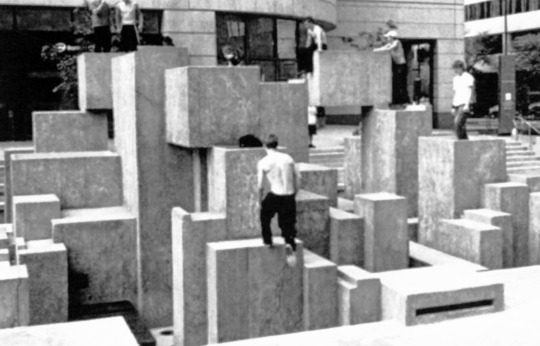
Lawrence Halprin, Skyline Park, Denver, Colorado, 1970-1975
#Lawrence Halprin#architecture#design#art#landscape#urban design#landscape architecture#skyline park#Denver#colorado#plaza#square#public space#public art
210 notes
·
View notes
Text

CITIES by Lawrence Halprin, Japanese Version
Translated by Teiji Ito
Shōkokusha (Publisher)
0 notes
Text
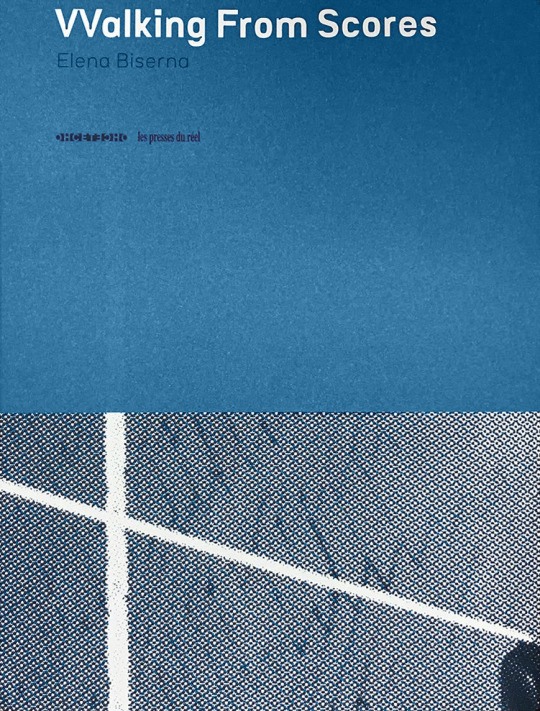
Walking from Scores, Edited by Elena Biserna, Les Presses du réel, Dijon, 2022, Second Edition 2023 [Good Press, Glasgow]





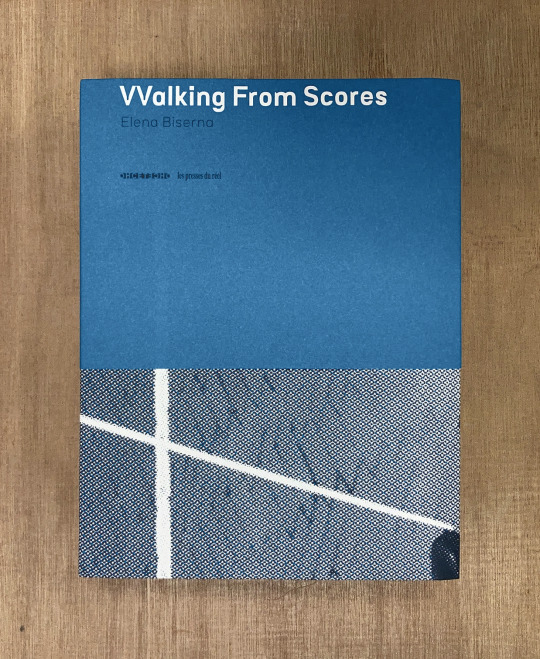
With scores and texts by Peter Ablinger, Milan Adamčiak, G. Douglas Barrett, Elena Biserna, Blank Noise, George Brecht, Cornelius Cardew, Stephen Chase, Giuseppe Chiari, Seth Cluett, Philip Corner, Viv Corringham, Bill Dietz, Amy Dignam, David Dunn, Haytham El-Wardany, Esther Ferrer, Simone Forti, Francesco Gagliardi, Jérôme Giller, Oliver Ginger, Anna & Lawrence Halprin, David Helbich, Dick Higgins, Christopher Hobbs, Jérôme Joy, katrinem, Debbie Kent, Bengt af Klintberg, James Klopfleisch, Milan Knížák, Alison Knowles, Takehisa Kosugi, Jirí Kovanda, Anne Leilehua Lanzilotti, Bob Lens, Ligia Lewis, Alvin Lucier, Walter Marchetti, Larry Miller, iLAND/Jennifer Monson, Max Neuhaus, Alisa Oleva, Pauline Oliveros, Yoko Ono, Open City & Emma Cocker, Nam June Paik, Michael Parsons, Ben Patterson, Cesare Pietroiusti, Mathias Poisson, Anna Raimondo, Pheobe riley Law, Jez riley French, Paul Sharits, Mieko Shiomi, Mark So, Standards, Nicolas Tardy, Davide Tidoni, Ultra-red, Isolde Venrooy, Carole Weber, Manfred Werder, Franziska Windisch, Ben Vautier, La Monte Young
#graphic design#typography#art#music#score#music score#catalogue#catalog#book#cover#book cover#elena biserna#les presses du réel#2020s
23 notes
·
View notes
Photo
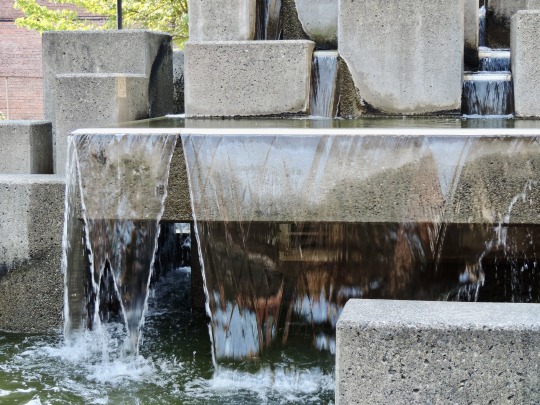
Brutalist Fountain, Broadway Maul, Tacoma, 2014.
I wonder how many fountains similar to this one were constructed. The idea originated with the Berkeley landscape architect Lawrence Halprin, and many cities across the US have, or once had, exemplars designed by his group. Many lesser talents also copied the idea, after all a concrete block fountain is rather easy, cheap, and quick to construct.
This photo was taken on a very hot August day when the moving water was attractive even if it did flow across concrete blocks.
#streetscape#fountain#brutalism#broadway maul#tacoma#pierce county#washington state#2014#photographers on tumblr#pnw#pacific northwest
18 notes
·
View notes
Photo

City Choreographer: Lawrence Halprin in Urban Renewal America Alison Bick Hirsch (2014)
https://lareviewofbooks.org/article/city-choreographer-lawrence-halprin-urban-renewal-america/
Anna Halprin is framed by Hirsch as a foil for Lawrence’s inconsistent public ambitions. Where Lawrence wanted to develop a model that could, if applied appropriately, be useful in facilitating democratic publics towards common aesthetic ends, Anna chose something more practical: to integrate her dance company. As a socially engaged artist, it was Anna, not Lawrence, who met with the political complexities of participation and was transformed. During the late 1960s and ’70s, Anna’s work morphed from a more traditional staged dance, to one where methodologies of movement are used as a tool of social amelioration (for cancer patients, victims of violence, the elderly). Lawrence’s work never managed a similar transformation, and community engagement never deeply affected his approach to designing and building landscapes.
Anna Halprin’s City Dance (1976–1977) was something like a dérive, a happening, and an experimental civic dance pageant. Using posters, radio, newspaper, and television to broadcast its open choreography, the dance invited San Francisco to take part in a procession. It began at sunrise on San Francisco’s Twin Peaks. Winding through the city from there, it ended at sunset on the (Lawrence Halprin-designed) Embarcadero Plaza. On the way, citizens were invited to join in, with or without costumes, to improvise, pretend they were on a rocket ship while riding BART, or move to the beat of diverse music in South Park. It was meant as an “open score” meeting of the whole city, where the people of San Francisco was enjoined to discover how they could move together in a more embracing manner.
Robby Herbst is a frequent contributor to KCET’s Artbound and a co-editor of Failure! Experiments in Social and Aesthetic Practices.
2 notes
·
View notes
Photo




Anna and Lawrence Halprin
Dance Office and me dancing at the office!
3 notes
·
View notes
Text
EVALUATING A CONSUMER GOVERNMENT COURSE
In this posting, there is one more concern this blog addresses regarding a proposed approach to civics education. For interested readers, they are encouraged to look up the posting, “A Practical Turn” (March 19, 2024). It is there that one finds the beginning of this effort. It can be found through the citation here,[1] or, along with subsequent postings, by using the archive feature of this blog. In total, those postings provide a rationale for the course of study being proposed.
As for the remaining concern, i.e., what this posting addresses, that would be the evaluation of the course itself – curriculum evaluation. To evaluate this course of study several aspects are reviewed. This evaluation scheme categorizes those factors according to a procedural model of evaluation devised by Lawrence Halprin.[2] The model is entitled the RSVP Cycle and seems more appropriate here than usual curriculum models because what is needed is not the evaluation of a school wide curriculum, but of a course of study.
While dated, this model is still well regarded.[3] The letters R, S, V, P refer to the categories of concerns or criteria Halprin says are present in ideal procedural relationships during the performance of a multidisciplinary event. Because of the decision-making emphasis of this course, such a model promises to be useful and is open-ended to concerns of the environment in which this course of study would be utilized.
The categories are:
R = resources upon which a course can draw.
Does this course operate within and take advantage of physical limitations?
Does this course operate within financial constraints?
Does this course respect societal, institutional, cultural expectations?
S = sources evaluating preparation processes leading to implementation.
Are the roles of participants defined and sensitive to their needs and dispositions?
Are the curriculum goals and objectives accepted by significant others?
Are time allocations reasonable for completion of tasks?
Are communication preparations adequate for acquiring needed information?
V = valuaction (coined term) which analyzes the consequences of actions (decisions) taken.
Are all predicted outcomes accounted for in the progression of the course?
Are values incorporated at decision points clearly stated and understood?
Are the two above concerns given adequate priority in terms of their utility?
P = performance, that is evaluation of actual behaviors during the process.
Are specified behaviors appropriate to meet curricular and instructional objectives?
Are behaviors and processes efficient?
Are processes flexible enough to meet reasonable unplanned changes?
It is suggested here that if this course were to take on any level of implementation among schools, that, for each implementation, this model be considered to develop evaluative instrument specifically suitable to that implementation, both on a summative and formative basis. This process should be done by school site curricular administrators.
A couple of things should be kept in mind. One, this course is offered as a transition stage toward an approach that is communal, a course guided by a liberated federalism construct. And two, if this course, with administrative approval, is only being utilized by a particular teacher – not a school or school district –these ideas are suggested to assist that teacher. That is, they should not be considered a “must do” list of required criteria. And with that, the rationale for a consumer government course of study is complete.
[Note: Due to medical reasons, this blogger is ceasing the blog’s Tuesday-Friday posting schedule. He anticipates he will, from time to time, issue new postings. He also wishes to thank readers for their readership.]
[1] URL: https://gravitascivics.blogspot.com/2024_03_17_archive.html.
[2] Lawrence Halprin, The RSVP Cycles: Creative Processes in the Human Environment (New York, NY: George Braziller, Inc., 1970).
[3] Interested? See URL, https://www.youtube.com/watch?v=QbIi966lOLs.
0 notes
Text
Performance and Movement
Definitions:
Performance-
The action or process of performing a task of function.
A musical, dramatic or other entertainment presented before an audience.
Movement-
An act of moving.
A change or development.

(Tilting "performance architecture" House Spins 360 Degrees)
Performance and movement look at the motions and processes of everything. From a play to how a building performs, everything Our performance as students or workers is always under review, to watch progress and to ensure we are performing at a good standard. We also keep an eye on the performance of items we use in our everyday lives, from our televisions and phones to our ovens and cars and so much more. Everything performs in different ways and to different standards. As explained on Arch Daily, the term ‘high-performing’ offers different views on performance, “ranging from a star student to a virtuosic violinist to a hard-working employee”.
In Shakespeare’s play, As You Like It, he states that “All the world’s a stage, and all the men and women merely players.” Here Shakespeare expands the idea of a stage and applies it to the whole world, and any action or movement made on the “stage” is part of the performance. This really emphasis’s that anything and everything that moves is classed as a performance.
Quotes:
“place and occasion mean more” than “space and time” – Aldo Van EYk (2008)
“any and all activities of human life can be studied as performance” – Schneider (2013)
“any movement creates invisible traces in the space that vanish almost instantly” – Sanchez (2020)
References:
As You like It. Directed by Shakespeare, 1623.
Cooke, Lacy. “Tilting “Performance Architecture” House Spins 360 Degrees,” InHabitat, 17 Dec. 2017, inhabitat.com/tilting-performance-architecture-house-also-spins-360-degrees/.
“Definition of Performance | Dictionary.com.” Www.dictionary.com, 2019, www.dictionary.com/browse/performance.
Fisher, Fiona. Performance, Fashion and the Modern Interior from the Victorians to Today. Oxford Berg, 2011.
Hornblower, Simon, et al. The Oxford Dictionary. 4th ed., Oxford, Oxford University Press, 2012.
María José Martínez Sánchez. Dynamic Cartography. Routledge, 28 July 2020.
“Movement.” Dictionary.cambridge.org, dictionary.cambridge.org/dictionary/english/movement.
Schechner, Richard. PERFORMANCE STUDIES : An Introduction. S.L., Routledge, 2020.
“The Ultimate Guide to High-Performance Building Design.” ArchDaily, 30 June 2022, www.archdaily.com/983363/the-ultimate-guide-to-high-performance-building-design.
After completing some research on performance and movement I believe that performance and movement can’t be put into a singular meaning or response. This is due to it covering such a wide range of topics and being applicable to everything.
Maria Jose Sanchez wrote a book called Dynamic Cartography which looks at scoring body movement as well as performance and space. Maria was born in 1982 in Murcia, Spain, and she is a former professional tennis player.
In Sanchez’s book, Dynamic Cartography, she talks about an American environmental designer, Lawrence Halprin (1916-2009). It is believed that Lawrence Halprin worked “at the intersection of architecture and dance”. By working within this interdisciplinary collaboration he used an advanced process within his designs called Motation. Sanchez explains that Motation is “a scoring system he developed which represents movement in relation to space”.
According to Sanchez, “Halprin applied a truly interdisciplinary process based on scoring actions within living environments”. Personally, this makes me think that in order to create any design or space, the actions of which will take place there need to be scored in order to create a successful environment and space. I believe this really emphasis’s the fact that performance and movement affect everything, including designs of future spaces. I find this quite interesting because other than looking at walkways and paths around a space I haven’t really considered thinking about what specific performances and movements will take place in a space I am designing.
Through my research I would say I have managed to come to a better understanding on the importance of performance and space within the design process. I have also learnt that designers work with other disciplines, such as dance, in order to score actions and create more successful designs. However, I do think that with my next topic I need to try and expand my research further.
0 notes
Text
_thinkMake Week 8 Reading
This week's reading was pages 39 to 46 of Lawrence Halprin's 'The RSVP Cycles: Creative Processes in the Human Environment'
The main things that I took from the text are detailed in my presentation I gave, attached below:


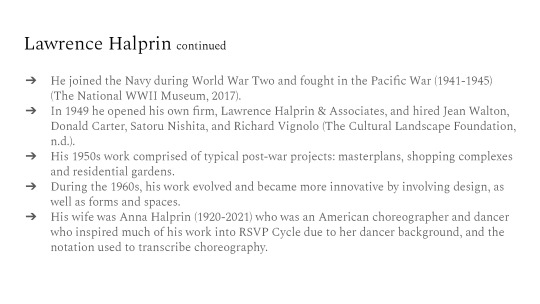






The words I chose from the text are:
Communication
Context
Visible
The verbs I have formed from these words are:
To communicate, to express
To contextualise, to place, to situate
To visualise, to highlight


First, a visualisation of the RSVP Cycle.
Secondly, a diagram of the processes required to turn the piece of wood, into the table, and then into the space detector.
0 notes
Photo
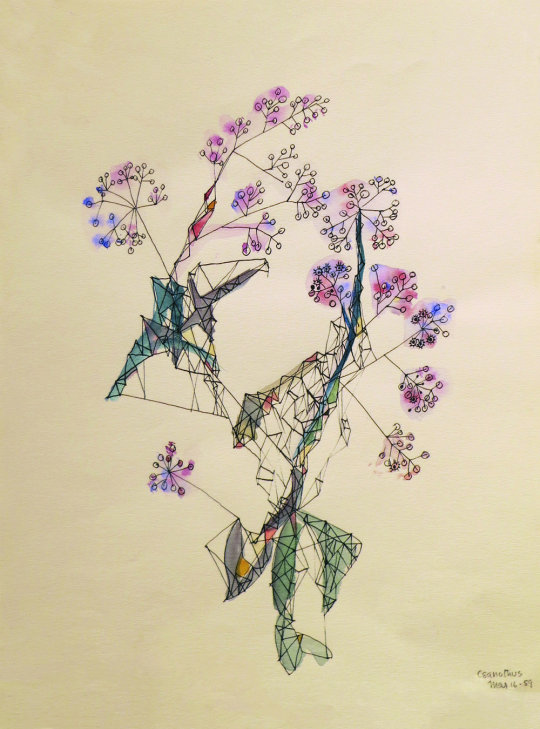
Lawrence Halprin(American, 1916–2009)
Ceanothus 1959 Pen and watercolor on paper 14 x 10 1/2 in. via
145 notes
·
View notes
Text

Lawrence Halprin & Associates, Angela Danadijeva, Project Designer, Edward McCleod & Associates, associated landscape architects, Freeway Park, Seattle, Washington, 1970-1976
#architecture#design#landscape architecture#landscape#freeway park#park#urbanism#urban park#landscape urbanism#Lawrence Halprin & Associates#Lawrence Halprin#Angela Danadijeva#Edward McCleod & Associates#Seattle#Washington
89 notes
·
View notes
Link
“He always found the strangest places.“
-Mandala book III - The Bounty
#hardworlds#setting#forgotten aesthetic#abandonded aesthetic#overcast#rain aesthetic#serial fiction#setting inspo
0 notes
Text
Honoring Our Heroes: The Veterans Memorial in Portland, Oregon
The Veterans Memorial in Portland Oregon is a place of remembrance and reflection, where visitors can pay tribute to those who have served our country. Located in Waterfront Park, this memorial honors the brave men and women who have sacrificed so much to protect our freedom.

The memorial was designed by artist Lawrence Halprin and dedicated in 1977. It features a series of walls made of black granite, which are inscribed with the names of more than 6,000 Oregonians who served in the military during World War II, the Korean War, and the Vietnam War. In addition to the walls, there is a central sculpture that depicts five soldiers in combat gear, representing the five branches of the military.
The Veterans Memorial is a powerful reminder of the sacrifices made by our service members and their families. It serves as a place of healing for veterans who may be struggling with the physical and emotional scars of war. Many visitors come to the memorial to honor loved ones who have served or to pay their respects to those who have made the ultimate sacrifice.
The location of the memorial is also significant. Waterfront Park is a popular destination for tourists and locals alike, and the memorial serves as a reminder of the importance of the military in our nation's history. Visitors can enjoy the scenic views of the Willamette River while also reflecting on the sacrifices made by our veterans.
In recent years, efforts have been made to update and improve the Veterans Memorial. In 2017, a $1.5 million renovation project was completed, which included the installation of new lighting, improved accessibility, and the addition of a new interpretive panel. The panel provides information about the history and significance of the memorial, as well as stories from veterans and their families.
The Veterans Memorial is also the site of several events throughout the year, including Memorial Day and Veterans Day ceremonies. These events provide an opportunity for the community to come together and pay tribute to our service members. The annual Rose Festival also includes a parade that passes by the memorial, allowing attendees to pay their respects while enjoying the festivities.
If you are planning a visit to Portland Oregon, the Veterans Memorial is a must-see attraction. It is a powerful reminder of the sacrifices made by our service members, and a testament to the strength and resilience of our nation. Whether you are a veteran, a family member of a veteran, or simply someone who wants to show their appreciation, the Veterans Memorial is a place where all are welcome to honor our heroes.
In conclusion, the Veterans Memorial in Portland Oregon is a beautiful and solemn tribute to those who have served our country. With its stunning black granite walls and central sculpture, it serves as a powerful reminder of the sacrifices made by our service members. Whether you are a veteran, a family member of a veteran, or simply someone who wants to pay tribute, the Veterans Memorial is a place where all are welcome to reflect on and honor our heroes.
Contact Us For More Information
Riverview Abbey Funeral Home
319 S Taylors Ferry Road,
Portland, OR 97219
Tel: 503-244-7577
1 note
·
View note
Photo

Keller Fountain Park- Lawrence Halprin
Landscape Design / Pools / Contours /
0 notes